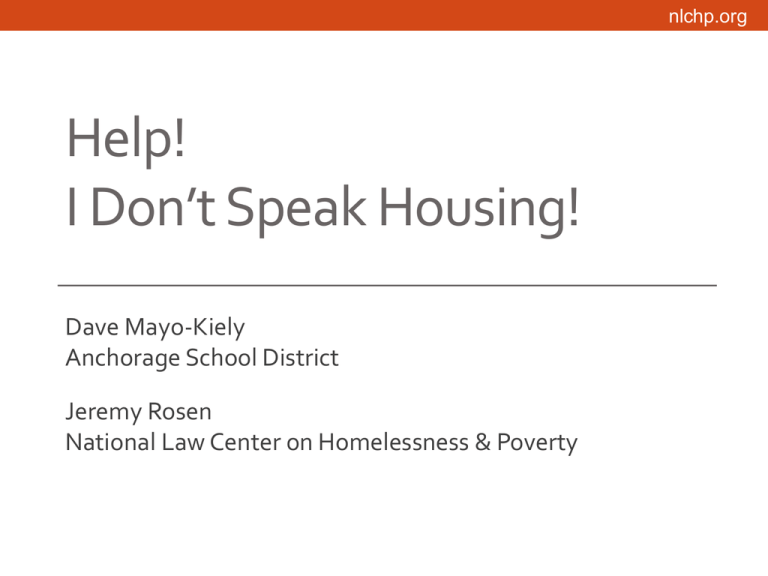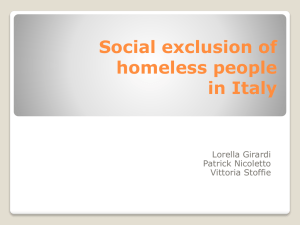
nlchp.org
Help!
I Don’t Speak Housing!
Dave Mayo-Kiely
Anchorage School District
Jeremy Rosen
National Law Center on Homelessness & Poverty
nlchp.org
nlchp.org
Goals
•Answer all your housing questions!
•Make sure when someone talks to you in housing speak, you
can answer right back.
•Motivate you to participate in local COC.
nlchp.org
Who Wants Alphabet Soup?
PTFA or ESG might keep a family in their home, but if that doesn’t work HUD
may tell you to try a PHA that can give you VASH or FUP, and if that doesn’t
work under the COC plan for implementing HEARTH maybe the family can
get PSH.
nlchp.org
What Does This Alphabet Soup Mean?
Protecting Tenants at Foreclosure Act or Emergency Solutions Grant might
keep a family in their home, but if that doesn’t work Housing and Urban
Development may tell you to try a Public Housing Authority that can give
you Veterans Affairs Supportive Housing or Family Unification Program, and
if that doesn’t work under the Continuum Of Care plan for implementing
Homeless Emergency Assistance and Rapid Transition to Housing maybe the
family can get Permanent Supportive Housing.
nlchp.org
What is HUD?
• A building in DC with a leaky roof?
• A federal housing agency?
• An old movie with Paul Newman?
• A group of people who don’t know
how to define homelessness?
nlchp.org
What is a CoC?
• Continuum of Care.
• Government agencies, nonprofit service providers, advocates,
and homeless / formerly homeless persons working together
to end homelessness in a local community, metro area, or
larger rural area of a particular state.
• Should you be part of the CoC?
• Even if you’re not in Fargo – “You betcha.”
• You are the voice for the kids and families you work with! Don’t assume
someone else is.
nlchp.org
What does a CoC do?
• Plans for ending homelessness in your community, sets
priorities for how your area’s homeless assistance funds will be
spent, and picks agencies who will receive the $$$.
• Taking more responsibility for managing grant funds, meeting
new outcome targets, and administering “broader” definition
of homelessness.
• What gives the CoC authority? HEARTH!
nlchp.org
Why do we care about HEARTH?
• Framework for how HUD’s homeless programs operate.
• New focus areas – more homelessness prevention and rapid
re-housing, less emergency shelter; more permanent housing,
less transitional housing.
• “Expansion” of homeless definition.
• All HUD funded homeless programs must do things for you
and the kids you serve!
nlchp.org
Concerns about HEARTH?
• HUD defines homelessness differently than US Department of
Education.
• Potential for ¾ of ED “homeless” not to be considered HUD
“homeless.” And even if “homeless”, eligible for what?
• Primarily those “doubled up” / in motels.
• Also burdensome documentation requirements.
nlchp.org
Categories of “Homeless”
Category 1
Literal Homelessness
• Individuals and families who live in a place not meant for
human habitation (including the streets or in their car),
emergency shelter, transitional housing, and hotels paid for by
a government or charitable organization.
• Families paying for motels themselves not covered.
nlchp.org
Categories of “Homeless”
Category 2
Imminent Risk of Homelessness
• Individuals or families who will lose their primary nighttime
residence within 14 days and have no other resources or
support networks to obtain other permanent housing.
• Seems like this would cover doubled up families but
burdensome documentation requirements mean that in most
cases it will NOT. Also, only eligible for prevention $$$.
nlchp.org
Categories of “Homeless”
Category 3
Homeless Under Other Statutes
• Unaccompanied youth under 25 years of age, or families with
children and youth, who do not meet any of the other
categories but are homeless under other federal statutes, have
not had a lease and have moved 2 or more times in the past 60
days and are likely to remain unstable due to special needs or
barriers.
• Again, documentation is a huge barrier! Also, only eligible for
prevention $$$.
nlchp.org
Categories of “Homeless”
Category 4
Fleeing Domestic Violence
• Individuals or families who are fleeing or attempting to flee
domestic violence, dating violence, sexual assault, or stalking
and who lack resources and support networks to obtain other
permanent housing.
• Does cover more people here; use it!
nlchp.org
What Can We Do?
• Homeless Children and Youth Act
• H.R. 5186 / S. 2653
• www.helphomelesskidsnow.org
• Makes all ED “homeless” (and RHYA, VAWA, Head Start, child
nutrition) eligible for HUD homeless programs and for a
broader range of services.
• Eliminates documentation requirements to prove eligibility;
simple referral form OK.
• Returns focus to community priorities.
nlchp.org
CoC Requirements
• Continuum of Care applicant is required to demonstrate that it
is collaborating with LEAs to assist in the identification of
homeless families as well as informing these homeless families
and youth of their eligibility for McKinney-Vento education
services.
nlchp.org
CoC Requirements
• Continuum of Care applicant is required to demonstrate that it
is considering the educational needs of children when families
are placed in emergency or transitional shelter and is, to the
maximum extent practicable, placing families with children as
close to possible to their school of origin so as not to disrupt
their children’s education.
nlchp.org
CoC Requirements
• Project applicants must demonstrate that their programs are
establishing policies and practices that are consistent with,
and do not restrict the exercise of rights provided by the
education subtitle of the McKinney-Vento Act, and other laws
relating to the provision of educational rights and related
services to individuals and families experiencing
homelessness.
nlchp.org
CoC Requirements
• Project applicants must demonstrate that programs that
provide housing or services to families are designating a staff
person to ensure that children are enrolled in school and
connected to the appropriate services within the community,
including early childhood programs such as Head Start, Part C
of the Individuals with Disabilities Act, and McKinney-Vento
education services.
nlchp.org
Continuum of Care
Emergency
Shelter
Prevention
Resources
Permanent
Supportive
Housing
Emergency
Shelter
Transitional
Housing
Permanent
Supportive
Housing
Assessment
Rapid
ReHousing
Transitional
Housing
nlchp.org
Prevention / Rapid Re-Housing
• Payments to avoid
eviction (rent arrears,
utilities, etc.)
• Assistance with move in
costs
• Temporary rent
subsidies
• What next?
nlchp.org
Emergency Shelter
• Shorter term
• Length of stay up to
•
•
•
•
120 days
No fees
Case management
Support services
Single site
nlchp.org
Bridge Housing
• Provides temporary housing until a housing option is available
• Emergency shelter may serve as the “bridge” until a Section 8
voucher is assigned.
• A family might be moved from the streets to a hotel room
until there is room in an ES.
nlchp.org
Transitional Housing
• For families needing a longer•
•
•
•
•
•
term intervention than ES
Length of stay up to 2 years
Case management
Intensive support services
Some single site, some
scattered site
HUD outcome: 65% exit to
permanent housing
Becoming disfavored!
nlchp.org
Housing First
• A philosophy
• End the homelessness by moving them into housing first.
• Work on other issues that may jeopardize the stable housing
while they are in housing.
• Support them in the housing.
• Services are voluntary.
nlchp.org
Permanent Supportive Housing
• Typically funded by HUD
•
•
•
•
•
McKinney-Vento
Housing subsidies
Program fees up to 30%
of income
Must have a documented
disability
Includes case
management and
ongoing support services
No time limit
nlchp.org
Affordable Housing
• Housing that a family is able to afford without exceeding 30%
of their income
• No time limit
• No programs or support services
• Lease = Landlord Tenant Act applies
nlchp.org
Subsidized Housing
• An option for low income families
• Makes market rate housing “affordable” for families at 30-80%
•
•
•
•
AMI
Typically subsidized by local or state tax credits
Typically mixed income properties
Must recertify annually; otherwise no time limit
Lease = Landlord Tenant Act applies
nlchp.org
Section 8 Housing
• HUD program with Public Housing Authorities
• Sex offenders and people with certain drug offenses are
•
•
•
•
ineligible
Other eligibility criteria determined by local PHAs
No time limit
Lease = Landlord Tenant Act applies
Project-Based
• Subsidy remains with the unit
• Housing Choice Voucher
• Subsidy remains with the family
• Family can select unit (based on FMR and inspection)
nlchp.org
Ask and You May Receive!?!?
Go talk to PHA (Public Housing Authority)!
• Do you have any Section 8 or public housing?
• What about when units turn over? (Another secret – most people only
keep Section 8 or public housing for a few years)
• Can we create a preference for homeless families? (They can if they
want to!)
• Got any FUP (Family Unification Program) or VASH (Veterans Affairs
Supported Housing)?
nlchp.org
Protecting Tenants at Foreclosure Act
• PTFA is a federal law protects tenants in properties where
owner was foreclosed on.
• After foreclosure, tenant does not have to move out right
away. Tenant can stay until end of lease or minimum 90
days.
• Must be bona fide tenant
(fancy way of saying
someone paying fair market
rent, and maybe not to
family member).
nlchp.org
PTFA
• May expire at end of 2014; your state may have a similar law.
• Find out at:
http://www.nlchp.org/documents/Eviction_Without_Notice
nlchp.org
Takeaways
• Understanding of COC, programs it administers, and need to
participate.
• Understanding of other housing resources for children, youth,
and families we care about, and ideas for accessing them.
• Ability to speak housing – use terminology with confidence.
nlchp.org
Contact Information
Dave Mayo-Kiely
Anchorage School District
(907) 742-3832
Mayo-kiely_david@asdk12.org
Jeremy Rosen
National Law Center on Homelessness & Poverty
(202) 638-2535 ext.210
jrosen@nlchp.org











